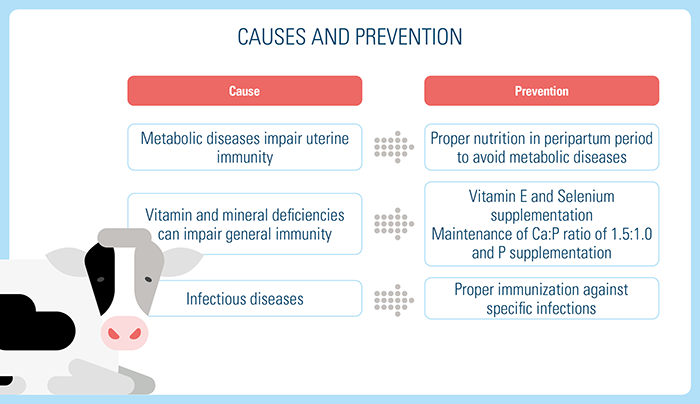

Retained Placenta
- Failure to expel the fetal membranes within 12 to 24 hours after calving
- Incidence varies per herd from 4.0-16.1%
- Age, parity
- Induction of parturition with PGF2
- Repeatability
- Stillbirth
- Shortened gestation
- Abortion of fetus
- Twinning
- Dystocia
- Fetotomy
- Cesarean section
- Vitamin E, selenium and carotene deficiency
- Immune suppression
- Metabolic disorders, especially milk fever
- Infectious diseases: Brucellosis, Leptospirosis, IBR, BVD1
The normal physiological stages of birth during parturition include dilation of parturient canal, delivery of the fetus and expulsion of the fetal membranes.
In normal condition, they are expelled within two to eight hours of parturition. Any retention beyond 12 hours could be considered pathological.
Normal Placental Separation
Cattle have cotyledonary placentas, wherein the fetal cotyledons are attached to the maternal caruncles of the uterus. Collagen links the interface together at several sites, and the breakdown of this collagen is likely a key factor in placental separation.
Both the secretion of relaxin and the decline of progesterone promote collagenase activity necessary for placental separation. Changes in the hormonal environment and maternal recognition of fetal major histocompatibility complex (MHC) Class 1 molecules also play an important role1.
Placental Retention
The absence of leukocytes chemotactic factors favor retained placenta2. Recently, it has been shown that lack of uterine motility plays little or no role in the occurrence of retained placenta.
Acute puerperium metritis and endometritis postpartum through:
- Increased bacterial multiplication in the uterus
- Impairment of immune function of endometrial macrophages and neutrophils by bacterial endotoxins
The goal is to hasten separation of the placenta and its expulsion from the uterine cavity as well as eliminate the bacterial contamination of the uterus.
Hormonal Therapy
Immediately administrating PGF2 or oxytocin post partum is not indicated, because they have low efficacy.
Anti-infective Therapy
Several studies indicate that approximately 50-80% of cows with retained fetal membranes exhibit elevated body temperature (> 39°C) for at least one day within 10 days post partum. It is not clear whether all such animals indeed would need a systemic treatment using an antibiotic for retained placenta in cows.
Intrauterine antibiotics used in the treatment of retained placenta should have high activity against E. coli and be free of irritating properties.
On many farms, all cows with a rectal temperature ≥ 39.5°C within the first 10 days post calving receive a systemic antibiotic treatment.
Homeopathic Products
Some products are thought to improve contractility of the uterine muscle and intensify the blood flow in the endometrium; however, evidence to support this is lacking.
Recent science indicates that retention of fetal membranes is associated with decreased immunity.

High dry matter intake and a ration with adequate energy and protein to overcome the negative energy balance are key. Calcium and phosphorus should be in the ratio of 1.5:1, adequate selenium at 0.08 and 0.07 mg/kg in dry period, along with vitamin E at the rate of 500 IU/cow/day.
- Tucho, T.T., Ahmed, W.M. 2017. Economic and Reproductive Impacts of Retained Placenta in Dairy Cows. Journal of Reproduction and Infertility 8 (1): 18-27.
- Davies, C.J., Hill, J.R., Edwards, J.L., Schrick, F.N., Fisher, P.J., Eldridge, J.A., Schlafer, D.H. 2004. Major histocompatibility antigen expression on the bovine placenta: its relationship to abnormal pregnancies and retained placenta. Anim Reprod Sci;82-83:267-80.

